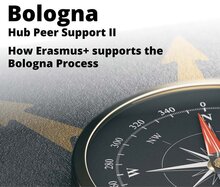By David Akrami Flores
25 Years of Bologna: Foundation of the European Higher Education Area

Podcast Episode 1
How Erasmus+ supports the Bologna Process

Arcade in the old university building in Bologna

Podcast Episode 2
The role of students in the Bologna Process
Objectives of the reform
One of the ministers’ primary objectives was to remove barriers to mobility by harmonising university degrees across Europe. They also wanted greater reliability and transparency in Europe’s higher education systems through quality assurance systems and the alignment of learning outcomes based on comparable national qualification frameworks. These core elements of the reform were designed to build mutual trust and establish a solid foundation for increased mobility.
The reforms sought to tackle some of the fundamental challenges facing higher education in Europe. Issues surrounding the recognition of academic achievements – whether obtained abroad or at another university in the same country – created major obstacles to student mobility. Additionally, higher education was often characterised by prolonged duration of studies, high age at graduation, low job market relevance, high drop-out rates and, particularly in the humanities, lack of structure and guidance in study planning.
The Bologna reforms were based on a fundamental paradigm shift. They placed students at the centre of the system and provided an impetus to focus once again on teaching, alongside research, as a core priority of university activities. Key changes included shifting away from knowledge transfer to competence-based learning, moving from supply-oriented teaching by defining clear learning outcomes, studying broader content within modules and introducing ECTS credits as a «currency» based on student workload rather than instructors’ teaching hours. There was also renewed emphasis on the quality of teaching and learning, with the recognition of academic achievements becoming the norm. These are the hallmarks of a student-centred higher education system.
Accomplishments
By restructuring study programmes, the Bologna Process required universities in Germany and elsewhere in Europe to undergo significant changes. But their endeavours have paid off. Today, more than 90 percent of the 21,000 degree programmes offered in Germany lead to a Bachelor’s or Master’s degree. These degrees are widely recognised on the labour market, allowing graduates to either start their careers earlier or continue their education in different ways – both within their own country and internationally.
The restructuring of study programmes has also made universities accessible to a more diverse student body. It is no coincidence that the increase in the student population in Germany – from around 2 million to nearly 3 million over the past 15 to 20 years – coincided with the sweeping changes in degree programme structures brought by the Bologna reforms. As a result, Bologna has made German universities more diverse and more inclusive – and simultaneously more open to students from non-academic backgrounds.
Another key achievement attributed to the Bologna reforms is Germany’s status as the third most popular host country for international students, with 370,000 currently enrolled. This level of international enrolment would probably not have been achieved without the adoption of the internationally comparable Bachelor’s and Master’s degrees. In light of the growing shortage of skilled workers, this achievement is especially satisfying, because around 50 percent of international students are studying the highly popular STEM subjects (science, technology, engineering and mathematics). Many of these students remain in Germany after graduating, drawn by promising career opportunities and streamlined residence regulations, thereby benefiting both the labour market and society in general.
However, this strong track record should not lead to complacency or cause us to overlook unachieved objectives. Increased academic mobility among young people at universities across Europe is clearly both desirable and urgently needed, especially at a time when European solidarity is weakening. Expanding the highly successful Erasmus programme would be both a logical and beneficial step. Additionally, efforts must focus on improving the automatic recognition of academic qualifications earned abroad. The dropout rate remains too high, particularly among international students – continued investment in improved support and supervision systems is essential.
The European Higher Education Area – a community of values
But where would we be today without Bologna? Likely in a fragmented European higher education landscape unable to compete with North America, Asia and Australia. And this brings us to one final important point.
Over the years, the European Higher Education Area has developed a remarkable ability to foster integration, extending its influence beyond the borders of the European Union. It now comprises 47 active member states with nearly 33 million students enrolled at over 4,000 universities. This unprecedented level of harmonisation has attracted significant interest, and Bologna-inspired reforms have been introduced in other regions of the world. These are achievements that are often overlooked in national debates.
And this «Bologna region» also sees itself as a community of shared values. Following the attack on Ukraine, the membership of Russia and Belarus was immediately suspended. For Ukrainian universities, Bologna is a critical «lifeline». Beyond NATO and EU perspectives, membership of the European Higher Education Area signifies not only participation in an educational reform process but also a commitment to participation in a free world in which fundamental academic freedoms are upheld.
Incidentally, according to the European University Association (EUA) report “Trends 2024 - European higher education institutions in times of transition”, 98% of universities consider the Erasmus+ programmes to be very important or important (90% very important, 8% important). 498 universities from 46 countries in the European Higher Education Area responded to the online survey.